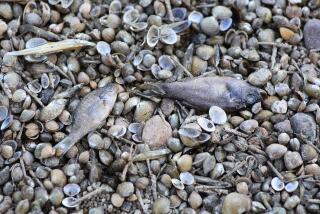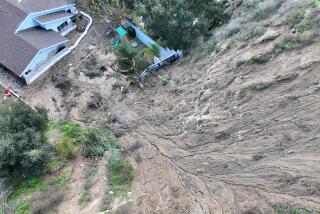After the Deluge, Lingering Swamps to Alter River Life : Environment: Temporary inland sea probably will delay recovery. Crisis is just beginning, a biologist says.
- Share via
TAYLOR, Mo. — The Mississippi River has spilled out as wide as 16 miles across the low plains of Illinois and Missouri, a chocolate-colored inland sea so vast that it will leave behind a temporary ribbon of swamps even after it recedes, altering human, wildlife and plant habitats for months to come.
Lingering floodwaters along the Mississippi’s 583-mile upper branch will likely delay a speedy recovery and wreak havoc on everything from the reclamation of sunken river towns to the survival of wild grasses, say scientists and engineers girding for the impact. Unlike earthquakes and hurricanes, which spend their fury in a matter of days, the Mississippi’s devastation is a quiet, invisible undermining that intensifies as long as floodwaters remain.
Mosquito and mayfly populations are already showing signs of exploding in the saturated bottom lands. River channels are filling with tons of silt. Thousands of birds are expected to stray off the Mississippi flyway during their fall migration. The risk of bacterial disease and drownings will rise among families trying to return to homes eroded by water, caked with silt and filling with river fish and poisonous snakes.
“What’s phenomenal is that even after the river crests, this crisis is not over. It’s just starting,” said Robert H. Stratton, a federal animal biologist who directs the Mark Twain National Wildlife Refuge, a 275-mile-long preserve now completely underwater.
Deep troughs of river may still cover some flood plains along the Mississippi’s upper branch as late as September, water specialists acknowledge.
“We’ve got above normal rainfall predicted until September so the water will sit in some places as long as late August and September before it drains out,” said Gary Dyhouse, chief hydrologist for the U.S. Army Corps of Engineers in St. Louis. “I wouldn’t be surprised to see some water still around by winter.”
From the air, the flood’s sway over the Mississippi valley is clear. North of the town of Quincy, the river bulges out to its greatest width, 16 miles of water lapping at the steel tops of 30-foot-high grain silos. Another muddy 15-mile band stretches farther south, at Clarksville, Mo. Even beyond those widening banks, small lakes and curling fingers of ground seepage splay for miles--evidence that standing water will not soon evaporate.
“Our district is gone,” Stratton shouted over the roar of a Cessna he uses to fly over his domain each morning. “The only way to inspect the refuge is by air or by boat. And all we have left to inspect is water.”
Beneath the swirling surface of the Mississippi, the strong 15-mile-an-hour current is shaving and planing the river bottom, altering the depths of boating channels. Buoy markers have been swept away “like matchsticks,” said Army Corps spokeswoman Denise Yale.
“The face of the river will change,” Yale said. “Boaters will have to relearn the river. Debris is changing the shoreline. We’ll get new sandbars at the bends.”
The Army Corps already expects it will have to dredge some of the river’s bottom to maintain the Mississippi’s standard 90-foot depths. And in some flooded areas, farmers will be forced to dynamite levees in order to drain off standing water as the river level recedes.
From dry land, dozens of flooded roads and highways lower into murky depths only to reappear miles away. Russell Miller, 73, an Illinois hog farmer, approached the southern end of the 16-mile Mississippi bulge, near the vanished town of Meyer, one recent morning. Trying to inspect his brother’s sunken farm, he swatted at dragonflies and funnels of mosquitoes as he ambled up to the edge of a rural route that submerges for 20 miles before rising again near the town of Warsaw.
“When it’s standing still, this water will do a terrible lot of damage,” Miller said, searching in vain for evidence of Ralph Miller’s barns and silos. “He’ll be lucky if it don’t wash away altogether.”
Even at low currents, river water is scouring thousands of abandoned houses. Walls bulge. Drywall and plaster flakes away. Stone foundations give way. Roofs above the waterline will snap off under a strong wind. Higher currents stir whitecaps that can tear buildings apart like tinder.
“Most of these homes, they’ll have to start from scratch,” said Dick Leach, 73, a Quincy, Ill., civil engineer who inspected scores of sunken houses after the Mississippi floods of 1965 and 1973. “And the ones that we can save, we’ll have to let them dry for a month or more before we can even get to work on them.”
Gravel has already been washed away from flooded secondary roads and trails. And the longer water remains, the more it erodes and strips off blacktop from sunken highways and rural routes.
“The public bill for road repair’s got to be enormous,” Leach said. “Anything in the path of a strong current will crumble.”
As the river recedes it will bare a thick claylike earth that local farmers call “gumbo.” Heavy with silt and difficult to remove, it will cover farm fields and coat the insides of houses, further delaying repairs and spiking costs. Even dry and stripped of the mud, many houses will be covered with sand deposits.
Residents returning to their homes will have to keep an eye out for snakes that lodge there as the waters recede. Timber rattlers and copperheads are common in the area and were often found during the 1973 flood, said Adams County Sheriff’s Deputy Ed Curless.
“You could get bit in that water if you reach in the wrong place,” Curless said.
Standing water has already begun to kill off all but the most durable vegetation by cutting off sunlight essential for photosynthesis.
Some river bank growth, greenbrier, poison ivy and prairie grass will last for weeks underwater, said Ed Adcox, an Army Corps ranger. But most other grasses and plants will yellow and die, leaving the land denuded, said Anna Hewings, a U.S. Agriculture Department plant pathologist. Those still alive after the water recedes will likely be stunted by fungus and rot, she added.
The damage to washed-out crops is evident, already being calculated in the billions of dollars. But the bare ground that remains will also likely have a stunning impact on this fall’s southern migration of teal, mallards, canvasback ducks and Canada geese, according to wildlife experts.
Normally a major flight corridor in the fall, the Mississippi’s farms provide sustenance for southbound bird populations. But this year, bare fields left by the flood will drive migrating birds away from the river, say Stratton and other experts. Some birds searching for scraps may attempt to fly beyond the flood areas, eventually weakening and dying. Most, though, will simply interrupt traditional flight patterns and find other routes.
Only the tallest trees are enduring the floods, said David Glenn-Lewin, a University of Iowa plant ecologist: “As long as most of their branches are above water,” he said, “trees can survive.” From his plane, 3,000 feet above the river, Stratton points out the tops of spiring cottonwoods, burr and pin oaks and maples.
In flatboat patrols of those areas, conservation officers and rangers have sighted raccoons and rabbits clinging to high branches, miles from the nearest dry land.
The fleetest animals--deer, pheasant, bobtail quail--have pushed inland, clustering in dwindling wooded spots. Deer herds have been reported wandering the streets of Quincy. Monday night, west of the embattled 52-mile-long Sny Island levee, an army of frogs marched over a gravel road toward high ground, displaced from their normal river habitat.
Nesting animals like mink and beaver are vulnerable, as are young deer and rabbits. Still, populations pared by the flood will rebound within a year or two, Stratton said.
Most Mississippi River farmers have saved their livestock. Adams County farmer Robert Shaffer, who saw half of his land swallowed when the Indian Grave levee went under Monday, removed all his cattle in advance. “They’d be helpless in that water,” he said. On Tuesday, Illinois emergency coordinator John Plunk issued a plea for trucks and volunteers to aid Quincy-area farmers working to save their livestock in the pelting rain.
Despite warnings, hundreds of hogs and cattle awaiting slaughter in pens at Denison, Iowa, were swept away last week by fast-rising water. Stratton’s staff have also sighted deer carcasses floating down the river.
Decomposing corpses add to the disease risk in the Mississippi, already churning with sewage, farm pesticides and chemicals. Hydrologists say the massive volume of the flood has diluted the ecological risk posed by toxic runoff.
But disease risk lingers. Last week, Larry Barker, public health director of Davenport, Iowa, went to the city’s downtown flood zone to make a televised appeal to watch out for disease risks. As he spoke, he watched dead fish, rusty nail-studded boards and fecal matter float by.
“It was a graphic illustration of the problems we could have,” Barker said. “I didn’t even have to say anything.”
Public safety officials say sewage spewed out by flood-jammed river city waste treatment plants from St. Paul to St. Louis poses a major health risk. In St. Paul, where flood waters are still receding two weeks after cresting, coliform bacteria counts have topped 1,600 particles per million--above the normal safe range of 1,000 parts per million, said Assistant Fire Chief Warren Schaub, who directed flood operations.
Other jurisdictions have reportedly found bacteria counts two to three times their normal level-breeding grounds for hepatitis A, diphtheria and dysentery, according to health officials who have repeatedly urged residents to avoid swimming in flood waters.
Only a few isolated bacteria-related cases have been reported. Barker and other Illinois and Missouri health officials say such incidents often go unreported long after patients have been hospitalized--or, in milder cases, are mistaken for flu or viruses and left untreated.
Despite efforts by police and National Guard reservists to keep residents out of floodwaters, children continue to swim in the area and adults regularly wade into the syrupy river wash to inspect their houses, risking disease.
“We repeatedly tell people to stay out of the water, but they keep going back,” Barker said. “They had better clean up real well.”
Standing water remains a risk as well for drowning. At least 21 people have died since rains began swamping the upper Midwest. Most of the victims underestimated the depth and speed of flood currents, law enforcement officials say. Three Missourians died last week after their four-wheel drive vehicle was swamped by flooding in Flat Creek in the southwestern area of the state.
“People think a four-wheel drive can go anywhere,” said the Army Corps’ Adcox. “They think they can just drive back to their flooded houses. Well, guess what? They’re floating tombs if the current’s strong enough.”
Mosquitoes, mayflies and other insect populations are beginning to soar near standing water troughs. In the federal wildlife preserve in Lacrosse, officers have already noticed increased swarms of insects.
When biologist Stratton returned from his morning flight over the roiling Mississippi Tuesday morning, he had only to stroll around the tiny airstrip to find signs showing this flood’s expected long incubation.
Mayflies coated an airstrip trailer, basking in the weak morning sun. On the farm field bordering the grass runway, shallow depressions brimmed with ground saturation. The sky above was blank, gray and birdless.
“A hurricane is over in 12 hours,” Stratton said. “Twelve months from now, we’ll still be feeling this.”
More to Read
Sign up for Essential California
The most important California stories and recommendations in your inbox every morning.
You may occasionally receive promotional content from the Los Angeles Times.










